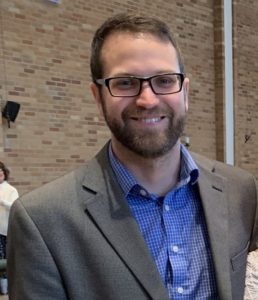Even though the Cyclones and Hawkeyes often duke it out on the field, court and mat, researchers from the two universities have come together to collaborate on a Department of Defense-funded project.

The project, titled “3D-Printed, Hierarchical Polymer-Bonded Energetic Composites with Electromagnetically Switchable Porosity,” is being led by principal investigator (PI) Xuan “Sean” Song, assistant professor in industrial and systems engineering at the University of Iowa (UI). Co-PIs on the project include Travis Sippel, associate professor of mechanical engineering (ME) at Iowa State University (ISU) and H.S. “Uday” Udaykumar professor of ME at UI. The team will build upon research first developed by Mitat Birkan and the Air Force Office of Scientific Research’s (AFOSR) Space Propulsion and Power branch.
The goal of the current research project is to create safer energetic materials that are less prone to accidental ignition. These accidental ignitions can occur when materials are being transported or otherwise handled and can have devastating consequences, including human casualties, when accidents occur.
“This project aims to develop intrinsically safe energetic materials resistant to accidental ignition by, for example, impact, drop, etcetera, whose sensitivity can be switched in an on-command manner through dynamic control of their structural properties,” Sippel said.
Sippel and student researchers in his lab will focus on enabling the sensitivity of an energetic material to be switched, electromagnetically, from an insensitive to ignition-sensitive state. Electromagnetic energy is an attractive means through which to interact with energetic materials, as many energetic materials are relatively transparent to microwave fields, according to Sippel.
Sippel and his group have recently developed a technique to wrap nanoscale thermites in graphene coatings, giving the thermite the property of microwave ignitability.
“By placing these graphene wrapped particles inside an energetic, we can achieve localized microwave heating and reaction of the graphene coated thermites,” said Sippel. “The chemical composition of the thermite, and replacing the thermite with other energetic materials can allow us to tune the resulting reaction to produce either high gas release, high temperature, or both.”
The project will also rely on the specific expertise of the UI researchers. Song will 3D print energetic materials containing the microwave sensitive energetics developed by Sippel and his team at ISU.
“This project will be one of the first to use 3D print to enable dynamic control of the energetic material’s energy release,” said Sippel. “The 3D printing technique Dr. Song’s group plans to use has never been used to print an energetic material and may offer advantages over techniques that have been used thus far.”
Udaykumar has developed a simulation framework for modeling the shock/compression wave initiation with energetic materials. His simulations have demonstrated, over several years, the ability to predict detonation properties of actual energetic material microstructures, including the effects of damage.
“Dr. Udaykumar’s involvement in the project will help the team understand how microwave-induced damage will affect energetic material sensitivity,” said Sippel. “The project will combine the unique strengths of Iowa and Iowa State in 3D print, energetic material simulation and energetic materials with goals of achieving a number of firsts and enabling the dynamic control of an energetic material’s sensitivity to ignition.”
Sippel and Udaykumar first connected in 2016 while attending a seminar sponsored by Iowa State’s Center for Multiphase Flow Research and Education (CoMFRE). At the time Sippel’s lab did not have the capability to perform detonation research. Through a project supported by the Defense Threat Reduction Agency, Sippel and ISU ME assistant professor James Michael, developed facilities capable of performing energetic materials detonation research.
“The facility we have developed is unique, only a few institutions in the country possess the capability to study detonation at the scale required by this project,” Sippel said.
Work on this project began in August, and funding will continue through July 2023. Funding for this project was made possible because of Martin Schmidt and AFOSR’s Dynamic Materials and Interactions branch. This project is part of a bigger $3.6 million effort funded by the Department of Defense.